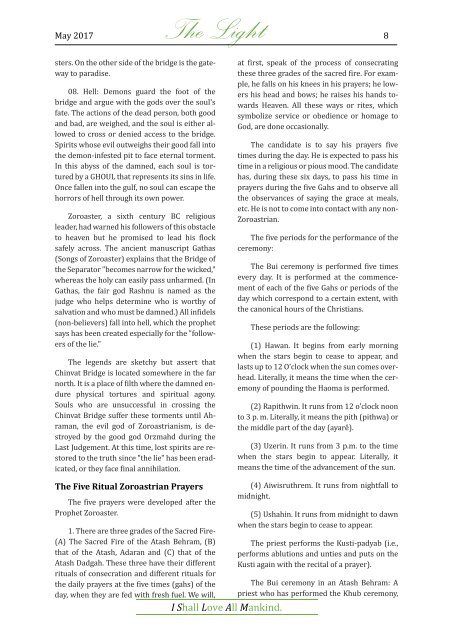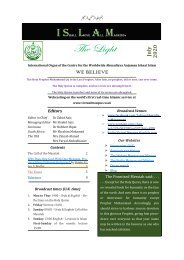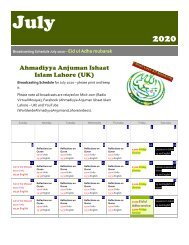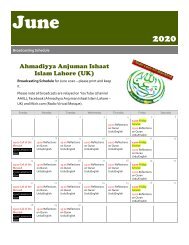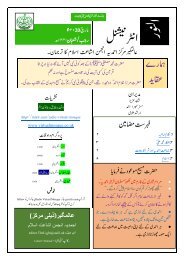2017 05 The Light May 2017
The International English organ of the Worldwide Ahmadiyya Anjuman Ishaat Islam based in Lahore. Presenting the Islam preached by the Holy Prophet Muhammad (s). A rational, scientific, liberal, inclusive and peaceful Islam.
The International English organ of the Worldwide Ahmadiyya Anjuman Ishaat Islam based in Lahore. Presenting the Islam preached by the Holy Prophet Muhammad (s). A rational, scientific, liberal, inclusive and peaceful Islam.
Create successful ePaper yourself
Turn your PDF publications into a flip-book with our unique Google optimized e-Paper software.
<strong>May</strong> <strong>2017</strong> <strong>The</strong><br />
<strong>Light</strong> 8<br />
sters. On the other side of the bridge is the gateway<br />
to paradise.<br />
08. Hell: Demons guard the foot of the<br />
bridge and argue with the gods over the soul's<br />
fate. <strong>The</strong> actions of the dead person, both good<br />
and bad, are weighed, and the soul is either allowed<br />
to cross or denied access to the bridge.<br />
Spirits whose evil outweighs their good fall into<br />
the demon-infested pit to face eternal torment.<br />
In this abyss of the damned, each soul is tortured<br />
by a GHOUL that represents its sins in life.<br />
Once fallen into the gulf, no soul can escape the<br />
horrors of hell through its own power.<br />
Zoroaster, a sixth century BC religious<br />
leader, had warned his followers of this obstacle<br />
to heaven but he promised to lead his flock<br />
safely across. <strong>The</strong> ancient manuscript Gathas<br />
(Songs of Zoroaster) explains that the Bridge of<br />
the Separator "becomes narrow for the wicked,"<br />
whereas the holy can easily pass unharmed. (In<br />
Gathas, the fair god Rashnu is named as the<br />
judge who helps determine who is worthy of<br />
salvation and who must be damned.) All infidels<br />
(non-believers) fall into hell, which the prophet<br />
says has been created especially for the "followers<br />
of the lie."<br />
<strong>The</strong> legends are sketchy but assert that<br />
Chinvat Bridge is located somewhere in the far<br />
north. It is a place of filth where the damned endure<br />
physical tortures and spiritual agony.<br />
Souls who are unsuccessful in crossing the<br />
Chinvat Bridge suffer these torments until Ahraman,<br />
the evil god of Zoroastrianism, is destroyed<br />
by the good god Orzmahd during the<br />
Last Judgement. At this time, lost spirits are restored<br />
to the truth since "the lie" has been eradicated,<br />
or they face final annihilation.<br />
at first, speak of the process of consecrating<br />
these three grades of the sacred fire. For example,<br />
he falls on his knees in his prayers; he lowers<br />
his head and bows; he raises his hands towards<br />
Heaven. All these ways or rites, which<br />
symbolize service or obedience or homage to<br />
God, are done occasionally.<br />
<strong>The</strong> candidate is to say his prayers five<br />
times during the day. He is expected to pass his<br />
time in a religious or pious mood. <strong>The</strong> candidate<br />
has, during these six days, to pass his time in<br />
prayers during the five Gahs and to observe all<br />
the observances of saying the grace at meals,<br />
etc. He is not to come into contact with any non-<br />
Zoroastrian.<br />
<strong>The</strong> five periods for the performance of the<br />
ceremony:<br />
<strong>The</strong> Bui ceremony is performed five times<br />
every day. It is performed at the commencement<br />
of each of the five Gahs or periods of the<br />
day which correspond to a certain extent, with<br />
the canonical hours of the Christians.<br />
<strong>The</strong>se periods are the following:<br />
(1) Hawan. It begins from early morning<br />
when the stars begin to cease to appear, and<br />
lasts up to 12 O’clock when the sun comes overhead.<br />
Literally, it means the time when the ceremony<br />
of pounding the Haoma is performed.<br />
(2) Rapithwin. It runs from 12 o'clock noon<br />
to 3 p. m. Literally, it means the pith (pithwa) or<br />
the middle part of the day (ayare ).<br />
(3) Uzerin. It runs from 3 p.m. to the time<br />
when the stars begin to appear. Literally, it<br />
means the time of the advancement of the sun.<br />
<strong>The</strong> Five Ritual Zoroastrian Prayers<br />
<strong>The</strong> five prayers were developed after the<br />
Prophet Zoroaster.<br />
1. <strong>The</strong>re are three grades of the Sacred Fire-<br />
(A) <strong>The</strong> Sacred Fire of the Atash Behram, (B)<br />
that of the Atash, Adaran and (C) that of the<br />
Atash Dadgah. <strong>The</strong>se three have their different<br />
rituals of consecration and different rituals for<br />
the daily prayers at the five times (gahs) of the<br />
day, when they are fed with fresh fuel. We will,<br />
I Shall Love All Mankind.<br />
(4) Aiwisruthrem. It runs from nightfall to<br />
midnight.<br />
(5) Ushahin. It runs from midnight to dawn<br />
when the stars begin to cease to appear.<br />
<strong>The</strong> priest performs the Kusti-padyab (i.e.,<br />
performs ablutions and unties and puts on the<br />
Kusti again with the recital of a prayer).<br />
<strong>The</strong> Bui ceremony in an Atash Behram: A<br />
priest who has performed the Khub ceremony,


